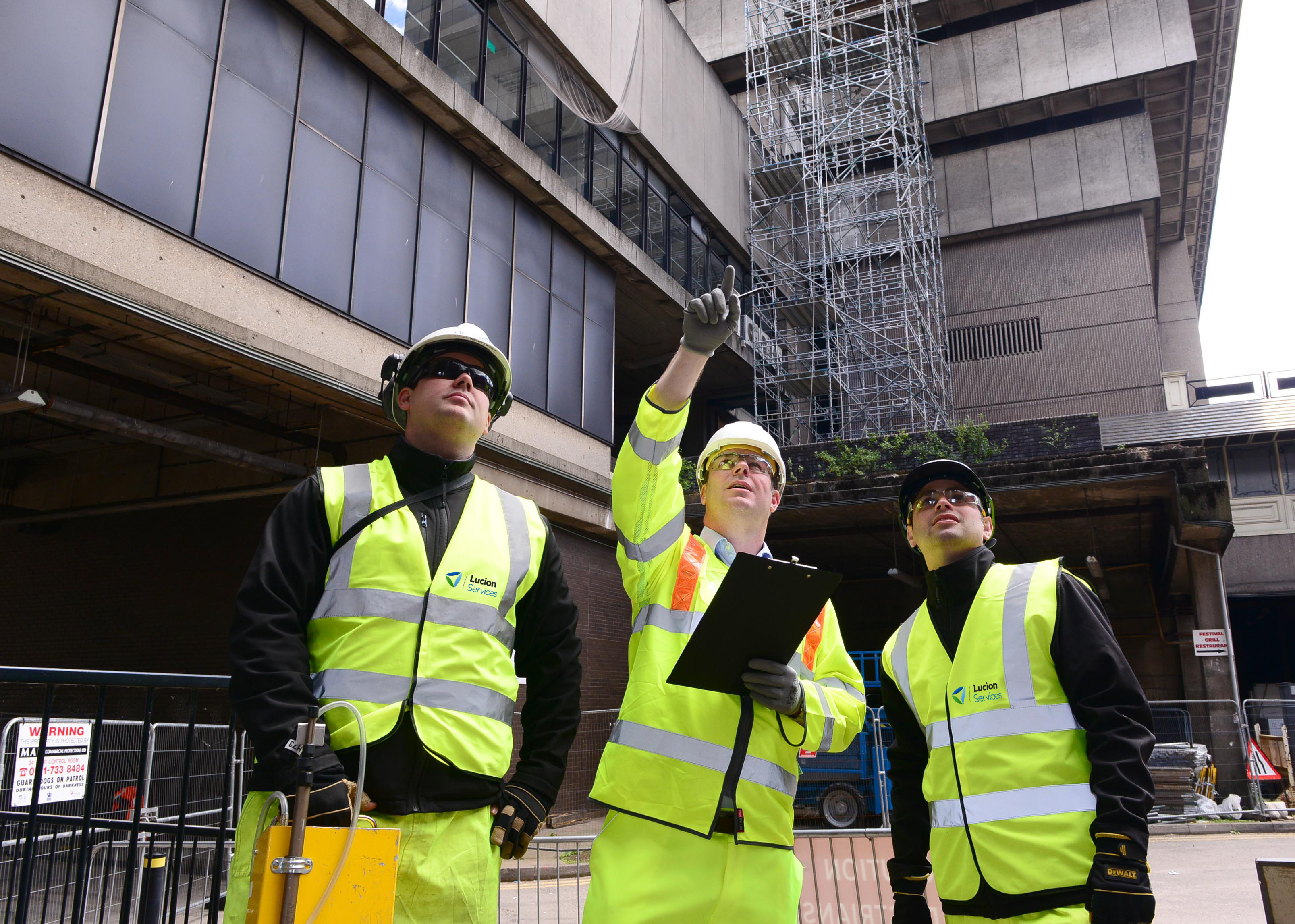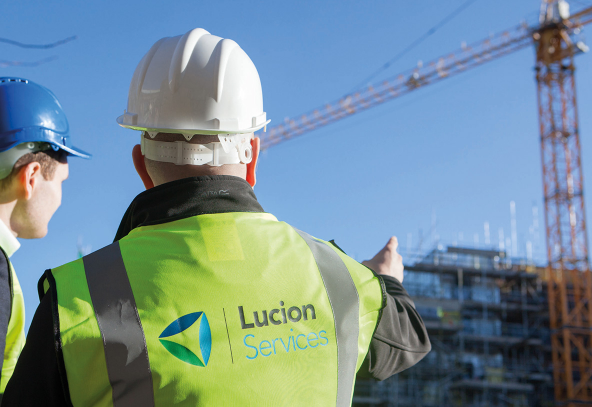What FM providers can do to manage asbestos risks
2 March 2021
As a Facilities Management (FM) provider it is often your duty to manage asbestos risk as part of the wider responsibility of managing the functionality and safety of the buildings you manage on behalf of your clients. We know that managing asbestos compliance across a large-scale property portfolio is a challenging task due to controlled budgets, occupancy pressures and access requirements.
At Lucion, we have over 18 years experience of in providing asbestos testing, inspection and consultancy services for many leading UK facilities management providers and therefore have expertise in how to manage asbestos effectively, ensuring compliance whilst also maintaining efficiency and cost/budget control.
Do you have a trusted asbestos consultant?
Managing asbestos across your portfolio of properties effectively means maintaining compliance with UK legislation, regulations and guidance. This requires expertise, practical experience and in-depth knowledge of the control of regulations (CAR) 2012 and it’s often true that FM managers do not have the expertise to manage asbestos properly.
Selecting a trusted asbestos consultant for your supply chain is therefore vital to ensure you remain compliant with relevant UK asbestos related legislation, guidance and best practices, including evolving your procedures alongside changing health and safety regulations.
Key questions to consider when selecting your asbestos consultant for surveying, analytical or testing works, include:
- Are they UKAS ISO 17020 and ISO 17025 accredited?
- Are they independent from licenced asbestos removal companies and how do they demonstrate impartiality?
- Do they have the resource and experience for the proposed programme of work?
- Do they have effective quality management systems in place?
Do you have a complete asbestos register for your properties and are you monitoring the condition of known asbestos on your sites?
The control of asbestos regulations (CAR) 2012 states you must complete a site-wide comprehensive asbestos management survey to identify any ACMs that could be disturbed during the general use of the building. This means surveying walls, floorings ceilings and within risers and service cupboards to check and record the location of any ACMs. This management survey creates the asbestos register for the site, which is a list of known ACMs, and should include all parts of the property. If the report has gaps or the survey was not a complete survey of all areas, rooms, floors etc. action should be taken to survey these areas to complete the survey.
Once your asbestos register is complete you need to implement a re-inspection programme to monitor the condition of known ACMs on your sites. Like any building material, asbestos-containing materials are subject to potential damage and degradation. As an asbestos product degrades it can be more likely to become a hazard to health, therefore it should be inspected at regular intervals to ensure its condition has not deteriorated.
Under CAR 2012 asbestos re-inspections should be conducted every 6-12 months depending on the asbestos survey report recommendations. Therefore, to demonstrate compliance with the regulations, any FM Manager should have in place an annual re-inspections programme to monitor the condition of known ACM on the sites that you have a duty to manage on.
Have you taken account of asbestos risk for your refurbishment programmes?
An asbestos pre-refurbishment survey should be carried out ahead of any refurbishment work that may disturb known and/or unknown ACMs to ensure the safety of the individuals working on your site. The HSE determines refurbishment work to be any work where the fabric of the building is disturbed i.e. window/door replacements and installation of telecoms, fire protection and utility services.
A trusted asbestos surveyor will be able to carry out an intrusive survey of the specific areas related to the work and provide a survey report containing recommendations on how to deal with any asbestos containing materials found in the work area. This could be to leave in situ if work will not disturb it, encapsulate it if it cannot be moved but will allow work to be carried out nearby, or remove it if it cannot be avoided.
You should ensure that you have budgeted for asbestos investigations and remediation at the earliest stage of any refurbishment work to prevent any disturbances of ACMs during the work and also to mitigate unplanned costs and delays to your project. If an ACM is found during the project and it needs to be disturbed as part of the work, work in the area will have to stop until the ACM is removed or encapsulated to prevent exposure to contractors working on-site. Therefore, to demonstrate good planning and best practice in line with CAR 2012, any FM Manager and contractors working on your sites should action an asbestos refurbishment survey as soon as the scope of work for the project is finalised.
Storing your asbestos data
Obtaining accurate, up to date asbestos survey reports and data from a competent provider you can trust is only one element of your compliance journey. It is important that the information for all properties is accessible for anyone potentially at risk, such as building contractors or staff at the property who are likely to disturb any asbestos present. With multiple properties, buildings and sites under your duty of care it’s very easy for asbestos reports and remediation information to be mislaid and or become outdated if not managed properly.
Anyone attending your properties, buildings and assets should have immediate access to the asbestos information for that information before starting any ‘work’. Traditional storage methods require accessing beforehand to find and print off or share an electronic copy of the asbestos report, and that to be sent to the contractor before attending. Paper records and local drive storage for your asbestos reports and registers are now fully out of date and even ‘static’ asset management IT systems are simply not fit for purpose anymore. We recommend storing all asbestos data in one accessible location, such as a purpose-built, online asbestos management database.
Our system, NexGen, allows you to view the compliance status of all properties in your portfolio on any web-enabled device and gives you the ability to share reports and registers with an unlimited number of colleagues and contractors. NexGen ensures that your reports and asbestos register are updated automatically after every job we complete, removing the timely and costly administrative processes involved with updating them manually. Storing all your asbestos data in one location allows you to have a full view of your compliance status and you can use this information to inform your future refurbishment work programmes, budgets, asbestos management plan and wider health and safety procedures.
Maintaining up to date procedures and training
Asbestos management plans (AMPs) are written plans detailing how the duty holder will manage any asbestos risks within buildings and assets that were constructed prior to the year 2000. AMPs are a legal requirement for all workplaces which contain asbestos under the control of asbestos regulations (CAR) 2012.
The items detailed in your asbestos management survey will form the foundations for the management plan and it should detail strategies for
- responsibility and management of risk,
- training and competency of employees and contractors working on-site that could potentially disturb asbestos in their work, and
- emergency procedures in case of accidental disturbance of asbestos containing materials.
The AMP should be reviewed regularly, at least on an annual basis coinciding with your re-inspections if possible, and should be updated immediately where any changes with the management of the building or asset occurs.
Reviewing the suitability and effectiveness of the AMP and any processes put in place will help to inform any amendments that may need to be made in order to help manage the asbestos risks. A professional and competent asbestos consultant will be able to support you in updating your AMP and ensure that it is fit for your purpose.
A trusted and professional asbestos consultancy will be able to carry out a training needs analysis on your organisation’s management structure and roles to identify what roles require which type of asbestos training. Required competency levels are based on responsibility in relation to asbestos risk, so an office employee who carries out administrative tasks only requires asbestos awareness training, however, a supervisor or manager who is responsible for staff and contractors working on-site doing maintenance or refurbishment work should have BOHS P405 Management of Asbestos in Buildings training or similar.
Reviewing the AMP on an annual basis will also help prevent a build-up of out of date and therefore unreliable or insufficient documentation. If you are using historic asbestos documentation to inform your AMP, but there is no trail or timeline relating to that documentation, it may be time to review the reliability of the information being used. We recommend carrying out new full or targeted asbestos management surveys and/or re-inspections where required to ensure that information within the AMP is fully comprehensive and up to date.
Tool Box Talk: Asbestos Awareness
As part of Lucion’s Take Care Be Aware initiative, we actively take care of our health and safety responsibilities, with continuous awareness of our commitments to knowledge share and educate.
In doing so we have created a ‘toolbox talk’ on asbestos awareness to raise awareness of the hazards associated with asbestos-containing materials, enabling safety professionals to share knowledge and overall save the time and effort in producing them for you and your teams.
_2.png)
Download From NexGen
Asbestos Removal Timeline
Want to know what is involved in an Asbestos Abatement project? From asbestos survey through to 4 stage clearance certification, find out what's involved with this step by step guide to Asbestos Abatement.
Download Now
Risk Assessment FAQs
Conducting your health and safety risk assessment can be a daunting task. Before you get started, read our clients' top risk assessment FAQs.
_4.png)
Download From NexGen


 NexGen
NexGen












